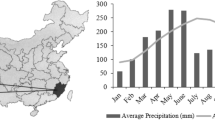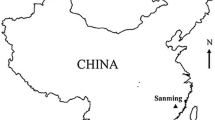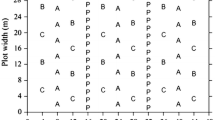Summary
A declining Picea abies (L.) Karst. stand produced as much foliage and branches as a healthy stand but less stemwood at a similar leaf area index and climate. Nutrient analyses revealed that most biomass components at the declining site had lower concentrations of calcium and magnesium, but similar nitrogen and potassium (except for lower potassium in younger needles) and higher phosphorus, manganese and aluminum than the respective components at the healthy site. Comparison of these data with the results from studies on the nutrition and growth of P. abies seedlings (Ingestad 1959) led to the conclusion that the healthy stand is in a balanced nutritional state, while trees at the declining stand have only 56% of the foliar magnesium concentration required to permit growth at a rate which could be achieved at their nitrogen status. It appears that acidic deposition, which involves an input of nitrogen and a leaching of cations from the soil, causes an imbalance in the availability of nitrogen and magnesium. Growth is eventually reduced as magnesium becomes limiting.
Similar content being viewed by others
References
Amundson RG, Walker RB, Legge AH (1986) Sulphur gas emission in the boreal forest. VII. Pine tree physiology. Water Air Soil Pollut 29: 129–147
Bosch von C, Pfannkuch E, Baum U, Rehfuess KE (1983) Über die Erkrankung der Fichte (Picea abies Karst.) in den Hochlagen des Bayerischen Waldes. Forstwiss Centralbl 102: 167–181
Forschner W, Wild A (1987) Comparative investigation on the nutrient composition of healthy and injured spruce of different locations. In: Mathy P (ed) Air Pollution and Ecosystems. Proceedings of a Commission of the European Communities Symposium, Grenoble, France, May 1987. D Reidel Publishing, Dordrecht, pp 604–608
Hantschel R (1987) Water and element balance of damaged, fertilized Norway spruce ecosystems in the Fichtelgebirge with respect to physical and chemical soil heterogeneity (in German). Bayreuther Bodenkundl. Ber. 3
Ingestad I (1959) Studies on the nutrition of forest tree seedlings. II. Mineral nutrition of spruce. Physiol Plant 12: 568–593
Ingestad T (1979) Mineral nutrient requirements of Pinus silvestris and Picea abies seedlings. Physiol Plant 45: 373–380
Ingestad T (1982) Relative addition rate and external concentration Driving variables used in plant nutrition research. Plant Cell Environ 5: 443–453
Ingestad T (1987) New concepts on soil fertility and plant nutrition as illustrated by research on forest trees and stands. Geoderma 40: 237–252
Ingestad T, Kähr M (1985) Nutrition and growth of coniferous seedlings at varied relative nitrogen rate. Physiol Plant 65: 109–116
Johnson DW, Turner J, Kelly JM (1982) The effects of acid rain on forest nutrient status. Water Res Res 18: 449–461
Kirkby EA, Pilbeam DJ (1984) Calcium as a plant nutrient. Plant Cell Environ 7: 397–405
Kozlowski TT, Constantinidou HA (1985) Responses of woody plants to environmental pollution. Part I. Sources and types of pollutants and plant responses. For Abst 47: 5–51
Krivan V, Schaldach G (1986) Untersuchungen zur Probenahme und-Vorbehandlung von Baumnadeln, zur Elementanalyse. Fresenius Z Anal Chem 324: 158–167
Lange OL, Gebel J, Schulze E-D, Walz H (1985) Eine Methode zur raschen Charakterisierung der photosynthetischen Lei stungsfähigkeit von Bäumen unter Freilandbedingungen.-Anwendungen zur Analyse “neuartiger Waldschäden” bei der Fichte. Forstwiss Centralbl 104: 186–198
Lange OL, Zellner H, Gebel J, Schramel P, Köstner B, Czygan F-C (1987) Photosynthetic capacity, chloroplast pigments, and mineral content of previous year's spruce needles with and without the new flush: analysis of the forest-decline phenomenon of needle bleaching. Oecologia 73: 351–357
Linder S (1987) Processes and functions at the primary producer level. D. Responses to water and nutrients in coniferous ecosystems. In: Schulze E.-D., Zwölfer H (eds) Potentials and limitations of ecosystem analysis. Ecological Studies, Vol. 61, Springer, Berlin Heidelberg, pp 180–202
Linder S, Ingestad T (1977) Ecophysiological experiments under limiting and non-limiting conditions of mineral nutrition in field and laboratory. In: Bicentenary Celebration of C.P. Thunberg visit to Japan, The Royal Swedish Embassy and The Botanical Society of Japan, pp 69–76
Linder S, Rook DA (1984) Effects of mineral nutrition on carbon dioxide exchange and partitioning of carbon in trees. In: Bowen GD, Nambiar EKS (eds) Nutrition of Plantation Forests. Academic Press, London New York, pp 211–236
Meyer J, Schneider BU, Werk KS, Oren R, Schulze E-D (1988) Performance of two Picea abies (L.) Karst. stands at different stages of decline. V. Root tip and ectomycorrhiza development and their relation to above-ground and soil, nutrients. Oecologia 77: 7–13
Nambiar EKS, Fife DN (1987) Growth and nutrient re-translocation in needles of radiata pine in relation to nitrogen supply. Ann Bot 60: 147–156
Nihlgård B (1985) The ammonium hypothesis-an additional explanation to the forest dieback in Europe. Ambio 14: 2–8
Oren R, Schulze E-D, Meyer J, Schneider BU, Heilmeier H (1988a) Performance of two Picea abies (L.) Karst. stands at different stages of decline. I. Carbon relations and stand growth. Oecologia 75: 25–37
Oren R, Schulze E-D, Werk KS, Meyer J, Schramel P (1988b) Performance of two Picea abies (L.) Karst. stands at different stages of decline. VII. Nutrient relations and growth. Oecologia 77: 163–173
Osonubi O, Oren R, Werk KS, Schulze E-D, Heilmeier H (1988) Performance of two Picea abies (L.) Karst. stands at different stage of decline. IV. Xylem sap concentrations of magnesium, calcium, potassium and nitrogen. Oecologia 77: 1–6
Rehfuess KE, Rodenkirchen H (1984) deÜber die Nadelröteerkrankung der Fichte (Picea abies) in Süddeutschland. Forstwiss Centralbl 103: 248–262
Rehfuess KE, Bosch C, Pfannkuch E (1983) Nutrient imbalances in coniferous stands in Southern Germany. Commun Inst For Fenn 116: 122–130
Schramel P, Wolf A, Klose B-J (1980) Analytical pre-treatment of biological material by wet-ashing methods. In: Bratter P, Schramel P (eds) Trace elements analytical chemistry in medicine and biology. Walter de Gruyter & Co, Berlin 1980
Schulze E-D, Oren R, Zimmermann R (1987) Wirkungen von Immissionen auf 30-jährige Fichten in mittleren Höhenlagen des Fichtelgebirges auf Phyllit. AFZ 27/2, 725–730
Smith RB, Waring RH, Perry DA (1981) Interpreting foliar analyses from Douglas-fir as weight per unit of leaf area. Can J For Res 11: 593–598
Staff H, Berg B (1982) Accumulation and release of plant nutrients in decomposing Scots pine needle litter. Long-term decomposition in Scots pine forest II. Can J Bot 60: 1561–1568
Tamm CO, Aronsson A (1988) Experiments simulating increased nitrogen deposition to forest ecosystems. Poster presented in a COST Workshop on Ecosystem Experiments, June 1988, Mitwitz, FRG
Ulrich B (1986) Die Rolle der Bodenversauerung beim Waldsterben: Langfristige Konsequenzen und forstliche Möglichkeiten. Forstwiss Centralbl 105: 421–434
Werk KS, Oren R, Schulze E-D, Zimmermann R, Meyer J (1988) Performance of two Picea abies (L.) Karst. stands at different stages of decline. III. Canopy transpiration of green trees. Oecologia 76: 519–524
Wyttenbach A, Bajo S, Tobler L (1985) Major and trace element concentrations in needles of Picea abies: Levels, distribution function, correlations and environmental influences. Plant Soil 85: 313–325
Zech W, Popp E (1983) Magnesiummangel, einer der Gründe für das Fichten-und Tannensterben in NO-Bayern. Forstwiss Centralbl 102: 50–55
Zimmermann R, Oren R, Schulze ED, Werk KS (1988) Performance of two Picea abies (L.) Karst. Stands at different stages of decline. II. Photosynthesis and leaf conductance. Oecologia 76: 513–518
Zöttl HW, Höttl RF (1986) Nutrient supply and forest decline in Southwest-Germany. Water, Air Soil Pollut 31: 449–462
Zöttl HW, Mies E (1983) Nährelementversorgung und Schadstoffbelastung von Fichtenökosystemen im Südschwarzwald unter Immissionseinfluß. Mitteilgn Dtsch Bodenkundl Gesellsch 38: 429–434
Author information
Authors and Affiliations
Rights and permissions
About this article
Cite this article
Oren, R., Werk, K.S., Schulze, ED. et al. Performance of two Picea abies (L.) Karst. stands at different stages of decline. Oecologia 77, 151–162 (1988). https://doi.org/10.1007/BF00379181
Received:
Issue Date:
DOI: https://doi.org/10.1007/BF00379181




